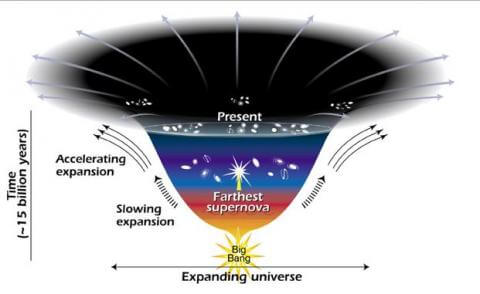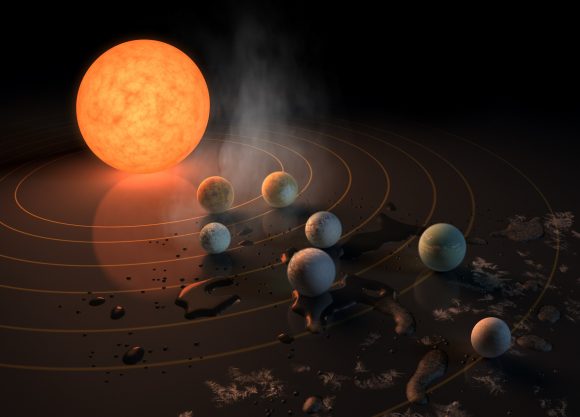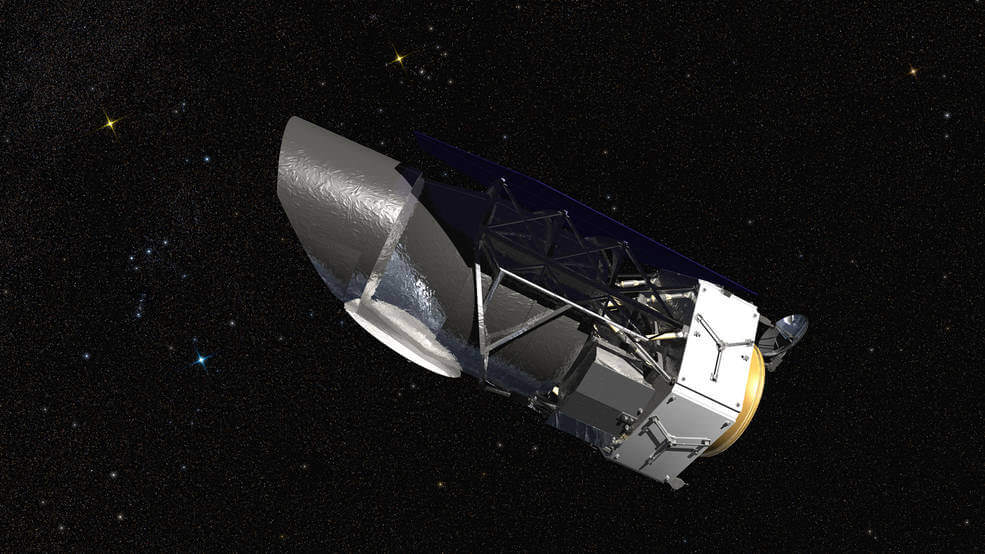We humans have an insatiable hunger to understand the Universe. As Carl Sagan said, “Understanding is Ecstasy.” But to understand the Universe, we need better and better ways to observe it. And that means one thing: big, huge, enormous telescopes.
In this series we’ll look at the world’s upcoming Super Telescopes:
- The Giant Magellan Telescope
- The Overwhelmingly Large Telescope
- The 30 Meter Telescope
- The European Extremely Large Telescope
- The Large Synoptic Survey Telescope
- The James Webb Space Telescope
- The Wide Field Infrared Survey Telescope
The Wide Field Infrared Survey Telescope (WFIRST)
It’s easy to forget the impact that the Hubble Space Telescope has had on our state of knowledge about the Universe. In fact, that might be the best measurement of its success: We take the Hubble, and all we’ve learned from it, for granted now. But other space telescopes are being developed, including the WFIRST, which will be much more powerful than the Hubble. How far will these telescopes extend our understanding of the Universe?
“WFIRST has the potential to open our eyes to the wonders of the universe, much the same way Hubble has.” – John Grunsfeld, NASA Science Mission Directorate
The WFIRST might be the true successor to the Hubble, even though the James Webb Space Telescope (JWST) is often touted as such. But it may be incorrect to even call WFIRST a telescope; it’s more accurate to call it an astrophysics observatory. That’s because one of its primary science objectives is to study Dark Energy, that rather mysterious force that drives the expansion of the Universe, and Dark Matter, the difficult-to-detect matter that slows that expansion.
WFIRST will have a 2.4 meter mirror, the same size as the Hubble. But, it will have a camera that will expand the power of that mirror. The Wide Field Instrument is a 288-megapixel multi-band near-infrared camera. Once it’s in operation, it will capture images that are every bit as sharp as those from Hubble. But there is one huge difference: The Wide Field Instrument will capture images that cover over 100 times the sky that Hubble does.
Alongside the Wide Field Instrument, WFIRST will have the Coronagraphic Instrument. The Coronagraphic Instrument will advance the study of exoplanets. It’ll use a system of filters and masks to block out the light from other stars, and hone in on planets orbiting those stars. This will allow very detailed study of the atmospheres of exoplanets, one of the main ways of determining habitability.
WFIRST is slated to be launched in 2025, although it’s too soon to have an exact date. But when it launches, the plan is for WFIRST to travel to the Sun-Earth LaGrange Point 2 (L2.) L2 is a gravitationally balanced point in space where WFIRST can do its work without interruption. The mission is set to last about 6 years.
Probing Dark Energy
“WFIRST has the potential to open our eyes to the wonders of the universe, much the same way Hubble has,” said John Grunsfeld, astronaut and associate administrator of NASA’s Science Mission Directorate at Headquarters in Washington. “This mission uniquely combines the ability to discover and characterize planets beyond our own solar system with the sensitivity and optics to look wide and deep into the universe in a quest to unravel the mysteries of dark energy and dark matter.”
In a nutshell, there are two proposals for what Dark Energy can be. The first is the cosmological constant, where Dark Energy is uniform throughout the cosmos. The second is what’s known as scalar fields, where the density of Dark Energy can vary in time and space.

Since the 1990s, observations have shown us that the expansion of the Universe is accelerating. That acceleration started about 5 billion years ago. We think that Dark Energy is responsible for that accelerated expansion. By providing such large, detailed images of the cosmos, WFIRST will let astronomers map expansion over time and over large areas. WFIRST will also precisely measure the shapes, positions and distances of millions of galaxies to track the distribution and growth of cosmic structures, including galaxy clusters and the Dark Matter accompanying them. The hope is that this will give us a next level of understanding when it comes to Dark Energy.
If that all sounds too complicated, look at it this way: We know the Universe is expanding, and we know that the expansion is accelerating. We want to know why it’s expanding, and how. We’ve given the name ‘Dark Energy’ to the force that’s driving that expansion, and now we want to know more about it.
Probing Exoplanets
Dark Energy and the expansion of the Universe is a huge mystery, and a question that drives cosmologists. (They really want to know how the Universe will end!) But for many of the rest of us, another question is even more compelling: Are we alone in the Universe?
There’ll be no quick answer to that one, but any answer we find begins with studying exoplanets, and that’s something that WFIRST will also excel at.

“WFIRST is designed to address science areas identified as top priorities by the astronomical community,” said Paul Hertz, director of NASA’s Astrophysics Division in Washington. “The Wide-Field Instrument will give the telescope the ability to capture a single image with the depth and quality of Hubble, but covering 100 times the area. The coronagraph will provide revolutionary science, capturing the faint, but direct images of distant gaseous worlds and super-Earths.”
“The coronagraph will provide revolutionary science, capturing the faint, but direct images of distant gaseous worlds and super-Earths.” – Paul Hertz, NASA Astrophysics Division
The difficulty in studying exoplanets is that they are all orbiting stars. Stars are so bright they make it impossible to see their planets in any detail. It’s like staring into a lighthouse miles away and trying to study an insect near the lighthouse.
The Coronagraphic Instrument on board WFIRST will excel at blocking out the light of distant stars. It does that with a system of mirrors and masks. This is what makes studying exoplanets possible. Only when the light from the star is dealt with, can the properties of exoplanets be examined.
This will allow detailed measurements of the chemical composition of an exoplanet’s atmosphere. By doing this over thousands of planets, we can begin to understand the formation of planets around different types of stars. There are some limitations to the Coronagraphic Instrument, though.
The Coronagraphic Instrument was kind of a late addition to WFIRST. Some of the other instrumentation on WFIRST isn’t optimized to work with it, so there are some restrictions to its operation. It will only be able to study gas giants, and so-called Super-Earths. These larger planets don’t require as much finesse to study, simply because of their size. Earth-like worlds will likely be beyond the power of the Coronagraphic Instrument.
These limitations are no big deal in the long run. The Coronagraph is actually more of a technology demonstration, and it doesn’t represent the end-game for exoplanet study. Whatever is learned from this instrument will help us in the future. There will be an eventual successor to WFIRST some day, perhaps decades from now, and by that time Coronagraph technology will have advanced a great deal. At that future time, direct snapshots of Earth-like exoplanets may well be possible.
But maybe we won’t have to wait that long.
Starshade To The Rescue?
There is a plan to boost the effectiveness of the Coronagraph on WFIRST that would allow it to image Earth-like planets. It’s called the EXO-S Starshade.
The EXO-S Starshade is a 34m diameter deployable shading system that will block starlight from impairing the function of WFIRST. It would actually be a separate craft, launched separately and sent on its way to rendezvous with WFIRST at L2. It would not be tethered, but would orient itself with WFIRST through a system of cameras and guide lights. In fact, part of the power of the Starshade is that it would be about 40,000 to 50,000 km away from WFIRST.
Dark Energy and Exoplanets are priorities for WFIRST, but there are always other discoveries awaiting better telescopes. It’s not possible to predict everything that we’ll learn from WFIRST. With images as detailed as Hubble’s, but 100 times larger, we’re in for some surprises.
“This mission will survey the universe to find the most interesting objects out there.” – Neil Gehrels, WFIRST Project Scientist
“In addition to its exciting capabilities for dark energy and exoplanets, WFIRST will provide a treasure trove of exquisite data for all astronomers,” said Neil Gehrels, WFIRST project scientist at NASA’s Goddard Space Flight Center in Greenbelt, Maryland. “This mission will survey the universe to find the most interesting objects out there.”
With all of the Super Telescopes coming on line in the next few years, we can expect some amazing discoveries. In 10 to 20 years time, our knowledge will have advanced considerably. What will we learn about Dark Matter and Dark Energy? What will we know about exoplanet populations?
Right now it seems like we’re just groping towards a better understanding of these things, but with WFIRST and the other Super Telescopes, we’re poised for more purposeful study.

